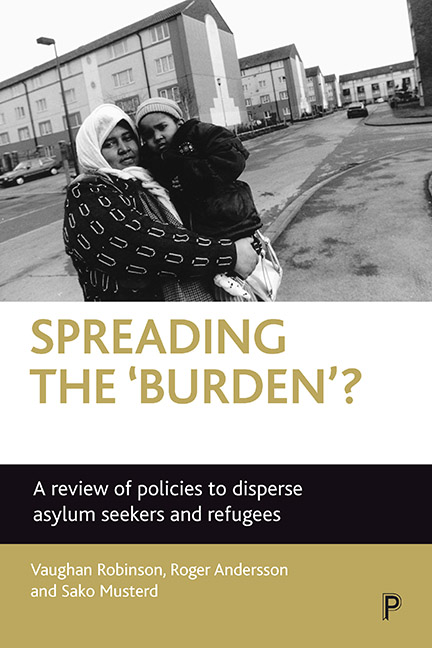Book contents
- Frontmatter
- Contents
- List of tables and figures
- Acknowledgements
- Glossary
- one Introduction
- two Defining the ‘problem’
- three Dispersal policies in the Netherlands
- four Dispersal policies in Sweden
- five Dispersal policies in the UK
- six What works? Improving the efficiency and effectiveness of dispersal
- seven Redefining the ‘problem’ and challenging the assumptions
- References
- Index
- Also available from The Policy Press
three - Dispersal policies in the Netherlands
Published online by Cambridge University Press: 20 January 2022
- Frontmatter
- Contents
- List of tables and figures
- Acknowledgements
- Glossary
- one Introduction
- two Defining the ‘problem’
- three Dispersal policies in the Netherlands
- four Dispersal policies in Sweden
- five Dispersal policies in the UK
- six What works? Improving the efficiency and effectiveness of dispersal
- seven Redefining the ‘problem’ and challenging the assumptions
- References
- Index
- Also available from The Policy Press
Summary
Introduction
This chapter describes in depth the various policies used by the Dutch government to spatially concentrate or disperse ethnic minorities. Particular attention is paid to those policies that were – and are – aimed at asylum seekers and refugees. The chapter is structured around three main sections. In the first section, the national context within which dispersal policies have to be analysed is roughly sketched, and immigration trends and developments in the Netherlands are outlined. The section also describes developments in Dutch migration and minority policy. The arrival of repatriates from the former Dutch East Indies after the Second World War is taken as the starting point, because they formed the first large group of immigrants the Dutch national government had to receive and house in the Netherlands. This immigration resulted in the first deliberate national dispersal policy.
The second section introduces and describes the main dispersal and concentration policies that have been put into practice in the Netherlands in the past, and considers what links them to contemporary asylum policy. In the third section, these programmes will be evaluated. It is hoped that this evaluation will be of considerable use when we come to assess future policies.
Since we have used English translations of Dutch governmental institutions, many abbreviations have come to be used throughout this chapter. To assist the reader to keep track of these, we have provided a brief glossary on page viii.
The Dutch context for dispersal policies
The Dutch are always proud to announce their tolerance towards ‘strangers’. The Netherlands has a long tradition, or so it is said, of welcoming refugees. However, this is by no means a fact of life: to what extent the Dutch have been hospitable to refugees is subject to continuous debate. Quantitative data have been used to show that the Netherlands is not as tolerant towards aliens as some often think (Bronkhorst, 1999), and indices have been developed to measure the degree of hospitality of the Dutch asylum policy (Kuiper, 1992). Recent data gathered by the Dutch Interdisciplinary Demographic Institute (NIDI) suggest that there is a large consensus on restrictive policies regarding the admission to – and residence of – foreigners in the Netherlands. However, the survey also showed that about 70% of the respondents to NIDI's survey thought the Netherlands had a moral obligation to admit refugees (Moors et al, 1999).
- Type
- Chapter
- Information
- Spreading the 'Burden'?A Review of Policies to Disperse Asylum Seekers and Refugees, pp. 25 - 64Publisher: Bristol University PressPrint publication year: 2003

